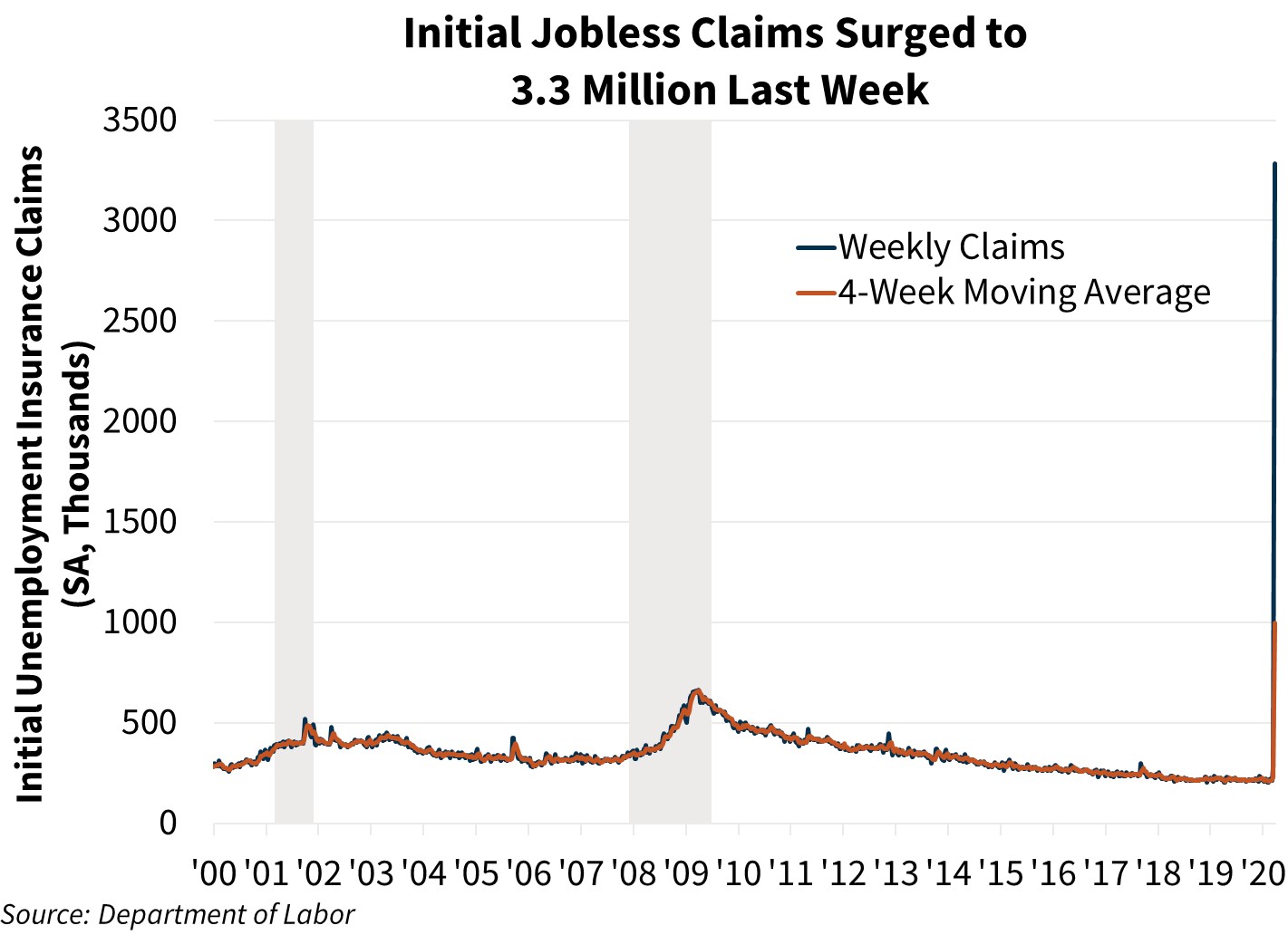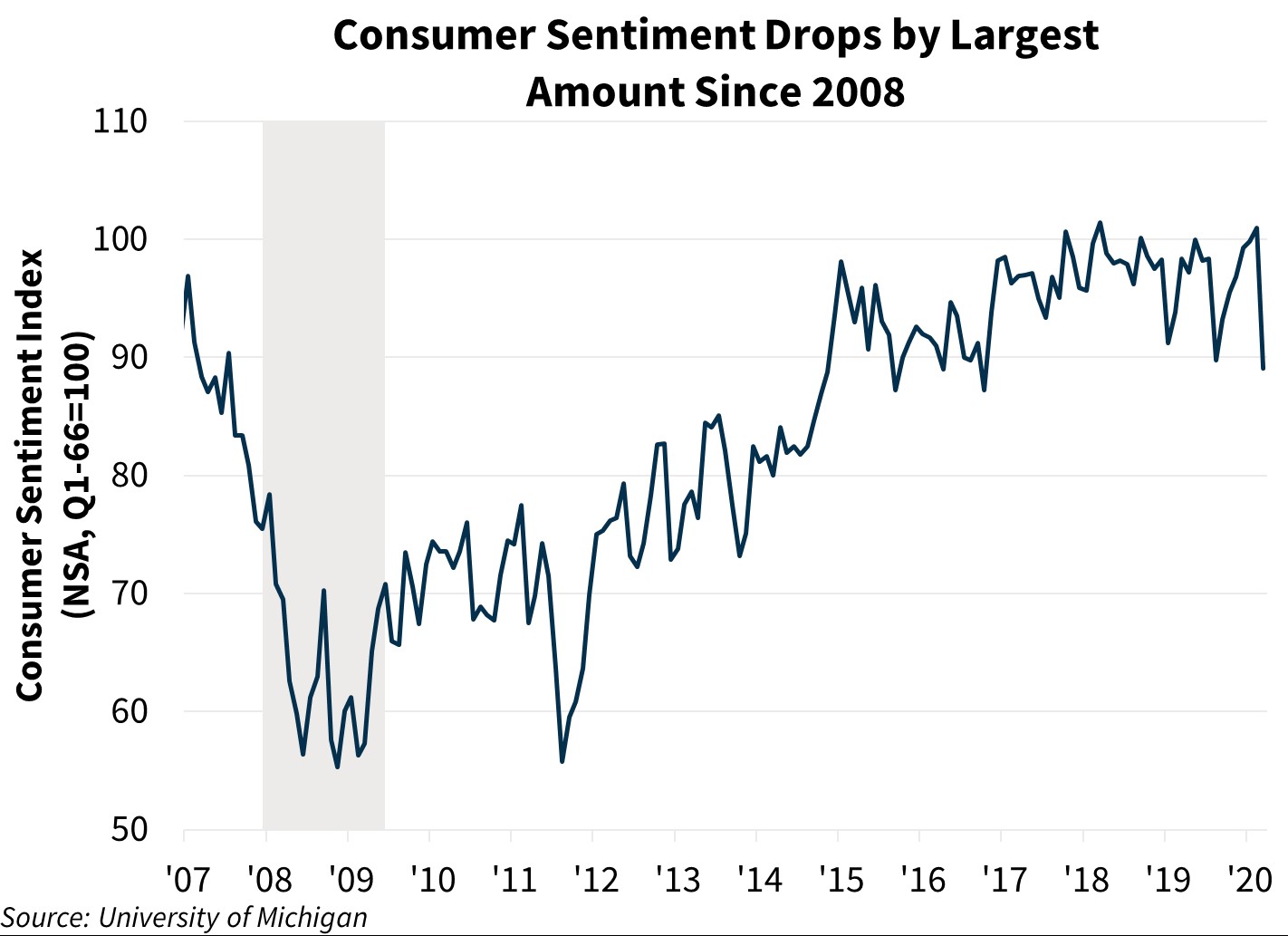Jobless Claims Surge as Businesses Close in Response to the Coronavirus
Key Takeaways:
Note: February data does not capture the recent escalation of the coronavirus in the U.S.
- The University of Michigan Consumer Sentiment Index fell 11.9 points to 89.1 in the final March reading. Both the current economic conditions and consumer expectations components drove the decline with the index for current economic conditions falling to the lowest level in over three years.
- Initial claims for unemployment insurance surged to 3.3 million in the week ending March 21, according to the Department of Labor, an increase of 3 million from the previous week.
- Personal income, adjusted for inflation, rose 0.5 percent in February, according to the Bureau of Economic Analysis, tying the largest increase in a year. Real PCE grew by just 0.1 percent for the third consecutive month, while real disposable income increased 0.4 percent. The personal saving rate rose three-tenths to 8.2 percent, the highest since March 2019.
- Durable goods orders rose 1.2 percent in February along with a similar increase in durable goods shipments, according to the Census Bureau. Core capital goods (nondefense excluding aircraft) shipments, an input for business equipment spending, fell 0.7 percent, the largest decline since September 2019. The forward-looking indicator, core capital goods orders, also declined.
- New single-family home sales fell 4.4 percent in February to a seasonally adjusted annualized rate of 765,000, according to the Census Bureau, the second highest level of the expansion. The for-sale inventory declined 6.2 percent from a year ago, but the months’ supply rose two-tenths to 5.0 months.
Forecast Impact
Real personal income was healthy in February, though the small increase in monthly consumer spending suggests that we may need to revise further downward our expectations for Q1 consumer spending. The decline in core durable goods orders and shipments also implies somewhat weaker business investment in Q1 than we had anticipated. Furthermore, these datapoints do not encompass the recent escalation of the coronavirus outbreak in the U.S., suggesting continued weakness in the coming months. The full extent of the response to the coronavirus pandemic has led to widespread business closures as consumer demand has been heavily limited by efforts to slow the spread of the virus. By April, we predict a sharp rise in the unemployment rate and continued deterioration in consumer sentiment. We now believe GDP growth in Q1 will likely be negative and Q2 will be substantially more negative. While housing data continued to show strength in February, the drop in consumer sentiment and social distancing efforts will likely lead to declines in home sales in the near future. We also believe the loss of employment will likely lead to an increase in forbearance actions for the mortgage industry and suppress the number of people who are able to refinance their mortgages in order to take advantage of historically low rates.


Details on Key Takeaways and Other Releases
- Personal income, adjusted for inflation, rose 0.5 percent in February, according to the Bureau of Economic Analysis. The PCE price index increased by 0.1 percent, and the core PCE price index increased by 0.2 percent. From a year ago, the PCE price index rose 1.8 percent, unchanged from January. The core PCE price index rose 1.8 percent on an annual basis, an acceleration of one-tenth from January.
- The University of Michigan Consumer Sentiment Index fell 11.9 points in the final March reading to 89.1. Consumer sentiment regarding current economic conditions dropped sharply, falling 11.1 points to 103.7. Consumer expectations declined by 12.4 points to 79.7, the lowest level since October 2016. Inflation expectations for the next five years were unchanged at 2.3 percent.
- Durable goods orders rose 1.2 percent in February, according to the Census Bureau. New orders of motor vehicles and parts jumped 1.8 percent, the largest increase since June 2019. Excluding transportation, new orders fell 0.6 percent. Shipments of durable goods increased 0.8 percent, while durable goods inventories were unchanged. Core capital goods orders declined 0.8 percent, while core shipments fell 0.7 percent.
- New single-family home sales fell 4.4 percent in February to a seasonally adjusted annualized rate (SAAR) of 765,000, according to the Census Bureau. New home sales in January were revised upward by 36,000 to 800,000 SAAR, the highest level since May 2007. Regionally, sales fell in the Midwest and West. The single-family median sales price (not seasonally adjusted) rose 7.8 percent from a year ago, the fastest annual pace of growth since April 2019.
Economic and Strategic Research Group
March 27, 2020
Opinions, analyses, estimates, forecasts and other views of Fannie Mae's Economic and Strategic Research (ESR) Group included in these materials should not be construed as indicating Fannie Mae's business prospects or expected results, are based on a number of assumptions, and are subject to change without notice. How this information affects Fannie Mae will depend on many factors. Although the ESR group bases its opinions, analyses, estimates, forecasts and other views on information it considers reliable, it does not guarantee that the information provided in these materials is accurate, current or suitable for any particular purpose. Changes in the assumptions or the information underlying these views could produce materially different results. The analyses, opinions, estimates, forecasts and other views published by the ESR group represent the views of that group as of the date indicated and do not necessarily represent the views of Fannie Mae or its management.
